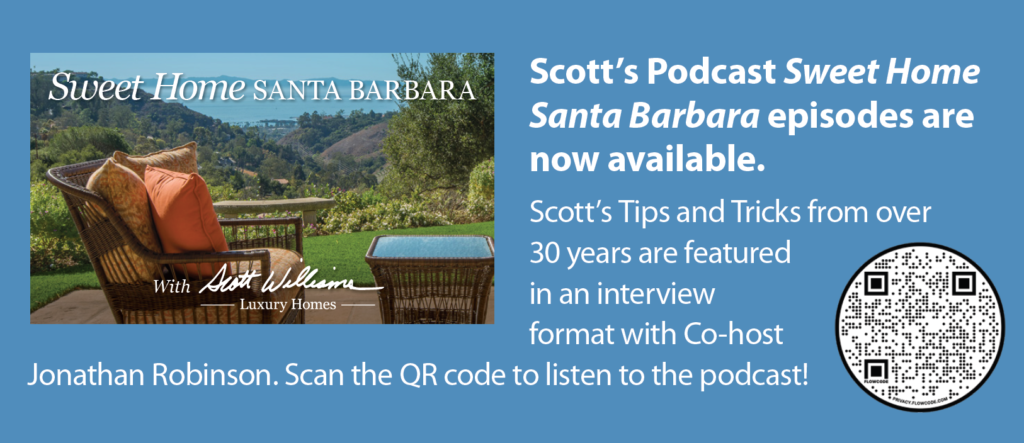
Over 30 Years Experience in 10 minutes
Episode 25: History of the East Side of Santa Barbara
Summary: Take a tour of the Eastside with Scott and Jonathan. Brought to life by historian Walker Tompkins this episode explores the first real neighborhood in Santa Barbara. Learn about the cradle of Santa Barbara.
Scott Williams Voiceover: Sweet home Santa Barbara, where the skies are so blue. Sweet home Santa Barbara, what’s worked for me can work for you.
Jonathan Robinson: Welcome to Sweet Home Santa Barbara. I’m your co-host Jonathan Robinson. And I’m with my trusty co-host and friend…
Scott Williams: Scott Williams.
Jonathan: …who’s an amazing realtor and, Scott, we’re doing something a little bit different in today’s podcast. We’re going to be talking about the history of the East side of Santa Barbara, which most people don’t know about.
I know, you know a lot about Santa Barbara history, and I think it’ll be really interesting for our viewers to learn how Santa Barbara got started and what the East side was like in the past and how it came to what it is now. I know very little, so I’m wondering what you can tell us about how Santa Barbara started?
Scott: Okay, here we go 250 years in 10 minutes. Well, the Presidio is what really is considered the founding of the town in 1782. This was really a Fort to protect the settlers from the Indians and bring Spanish law because we were a Spanish territory in those days.
They did succeed in doing those things, but it was never used militarily.
This part of Santa Barbara life, the Spanish days was up until 1846. This was the very final part of the Spanish empire, the last military outpost in the new world for them.
By the time California became a state in 1850, the Presidio had pretty much deteriorated into ruins and, of course, you can now know, but most people can visit the Presidio because it has been rebuilt as a state historical park. It’s right in the middle of downtown Santa Barbara, the corner of Canon Perdido in Santa Barbara Street.
Please visit that part of our history by going down there to see it. In 1851, they did a survey laying out the grid of the streets of Santa Barbara and then this ran State Street down the middle and creating the East side and the West side with that survey. By happenstance, the Royal Presidio, which was the center of the town’s life for about 60 years, ended up on the East side.
Jonathan: That’s interesting. Yeah, I’ve heard that Santa Barbara was once largely a marshland. Is that true?
Scott: Yeah, it doesn’t seem possible today, but the East side, for more than a century and a half was in a sterile or a dry salt marsh that extended from the beach area up to present day, the high school, Santa Barbara high school. In heavy storms it filled up with water, turned into a marsh and that’s our history of what the downtown was like, not so solid.
By the 1860s, his whole place was turning into farmland because it was fairly rich soil. It was pretty fertile. They were farming for berries and vegetables and maize, which is corn. The word milpas is the Spanish word for maize fields or corn fields. It’s now the name of the primary business street in the East side Milpas Street.
The townspeople did a ditch that is called Laguna Street that went from the marsh all the way down to the beach and drained the marsh into this whole swampy area for about 10 blocks, that was how long that was.
Today, because they had built up on the edges of the estero , the dumps of Santa Barbara and those places today are the Ortega Park, the Santa Barbara Junior High School and the city building department. Those were all the old dumps from the estero days.
Jonathan: Wow, that’s interesting. I imagine these marshy areas fully dried after a while, what happened then?
Scott: Well, it was a flat open space and for a long time this was sort of the, where the city gathered rodeos would set up their tents there, the circus, there was a race track, a very popular baseball field that seated 2500 people, exhibitions of various sorts would all set up in this part of town.
Back in the day of the by-plane airplane Barnstormers they would come and land their planes here. All this was entertainment to the city’s residence.
Jonathan: Sounds like fun. I don’t know what the history of how Santa Barbara got a university. You know anything about that?
Scott: Well, it did start in this part of town. It actually started, 1893, a wealthy Bostonian, Anna Blake started a school to provide free schooling to local elementary school children. Over the years, over about a 50-year period of time, that school evolved, eventually became a state teacher’s college and that turned into UCSB.
Jonathan: Wow. Interesting. So, what else can you tell us about the early days of Santa Barbara?
Scott: Well, this part of town from the 1890s on, the wealthy decided that this was the part of town they wanted to live in so North of Valerio Street, up to about where the mission is, they built some of their mansions.
Further South, the East side became the city’s racial melting pot where the less economically advantaged people lived. There were successive waves of Mexicans, Italians, Chinese and African American. All these communities flourished each with social and political gathering places. A big event in 1887 saw the arrival of the Southern Pacific Railroad.
There was still a bit of wet, a sterile marsh land so they built it up on trestles and crossed that area and the train came in from Southern California to Santa Barbara, bringing the outside world to the town.
Jonathan: That’s always a big thing when the train comes to town. I didn’t know they had to build it over marshland. That’s interesting. What’s the history of the courthouse and the Lobero?
Scott: Well, the most famous building on the East side is the Moorish Byzantine Spanish style courthouse, the county courthouse. It’s one of the most photographed and visited public buildings in the United States. I often see it ranked as one of the top 10 or near the top of the top 10 public buildings in the United States. It was built for the poultry sum of only $1.5 million in 1929, just before the crash.
Jonathan: I imagine it would be worth a little bit more nowadays.
Scott: Oh, yes, absolutely. You couldn’t probably replace the windows for a million and a half currently. It is four stories tall and for people who’ve never been there, the best view in the entire town is on top of the courthouse, on top of the clock. It’s free and anybody can go up there. It’s really spectacular.
Now you ask about the Lobero, Jose Lobero was a saloon owner, and he built an adobe opera house in 1872. I’m not quite sure what kind of operas saloon owners think that you should have in a fine cultural city like Santa Barbara, but it was the first theater in California between San Francisco and Los Angeles.
They eventually tore that down and in a 1924 the present Lobero Theater was constructed, right at the same site. It’s calling itself the oldest continuously running theater West of the Mississippi and it does support that we are a culturally sophisticated important center.
Jonathan: We are.
Scott: Well, Santa Barbara’s East side is easily the most diverse neighborhood in the city. It contains the industrial commercial center, homes, mansions, and it has the most important government buildings. It’s the birthplace of the city and many wish to make their homes in this richly historic area.
Jonathan: Fascinating history. I didn’t know hardly any of that. I hear you’re going to be doing some other parts of Santa Barbara in future podcast so people can know the city that they live in. I think that’s a great service. How do people get a hold of you if they want to talk to you and ask you about your real estate expertise?
Scott: I’m Scott at Scott@scottwilliams.com.
Jonathan: Well thank you, Scott, and thank you for listening to Sweet Home Santa Barbara.
Scott Williams Voiceover: Thank you for listening. Please subscribe to our podcast on your favorite app. If you know someone preparing to sell their home, please tell them about the podcast. Visit scottwilliams.com to contact me and download the two free E-booklets: Is My House Salable Now and How Not to Buy a Money Pit. Thank you for listening.

© 2023 Berkshire Hathaway HomeServices California Properties (BHHSCP) is a member of the franchise system of BHH Affiliates LLC. BHHS and the BHHS symbol are registered service marks of Columbia Insurance Company, a Berkshire Hathaway affiliate. BHH Affiliates LLC and BHHSCP do not guarantee accuracy of all data including measurements, conditions, and features of property. Information is obtained from various sources and will not be verified by broker or MLS. Buyer is advised to independently verify the accuracy of that information.
All Rights Reserved.

